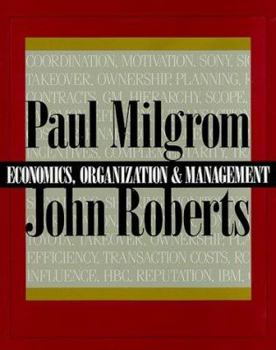Economics, Organization and Management
A systematic treatment of the economics of the modern firm, this book draws on the insights of a variety of areas in modern economics and other disciplines, but presents a coherent, consistent,... This description may be from another edition of this product.
Format:Paperback
Language:English
ISBN:0132246503
ISBN13:9780132246507
Release Date:February 1992
Publisher:Pearson
Length:640 Pages
Weight:3.15 lbs.
Dimensions:1.4" x 8.1" x 10.5"
Customer Reviews
4 ratings
Over Amitious
Published by Thriftbooks.com User , 18 years ago
While I really love this book (have studied it in detail from cover to cover) it tries to do too much. It covers the CAPM model for example, but doesn't go into enough detail so that a reader can really get a good grasp of the model. Also, it shies away from using proper mathematical analysis of some models (as with many other American textbooks) which will give a naive reader a false sense of security. Otherwise a great book, it's breadth and readability is excellent - would love an update sometime :)
Interesting and still relevant text on business economics
Published by Thriftbooks.com User , 19 years ago
Paul Milgrom and John Roberts are big name professors at Stanford. You know they are big name because on the cover of the book their names are bigger than the title. That's sort of the definition, right? Seriously, this is a very fine book. Even though it is a dozen years old and much has happened in the theories of organization, compensation, and incentives, the information in this book remains valuable. The book has 17 chapters organized in 7 parts. They are: 1)Does Organization Matter 2)Coordination: Markets and Management 3)Motivation: Contracts, Information, and Incentives 4)Efficient Incentives: Contracts and Ownership 5)Employment: Contracts, Compensation, and Careers 6)Finance: Investments, Capital Structure, and Corporate Control 7)The Design and Dynamics of Organization I think that presenting these business topics as topics in economics is very helpful in developing the right habits of thinking. While the book is not heavy in mathematics, it does present the relevant formulas and does not shy away from serious discussions of economics. In this way it is a very practical and applied text. While this book has been and should continue to be used in classes, I hope it gets a larger audience in the general readership interested in business and economics. It really is that interesting and well written.
A textbook on the firm.
Published by Thriftbooks.com User , 21 years ago
This book is probably the first textbook on economics of organization. Since published in 1992, it has been widely used in classes. The main framework of the book lies in the conception of the firm as a system of incentive/coordination to allocate efficiently resources. So this book is an extension of neoclassical approach to the area of organization, though such concepts like bounded rationality and transaction cost are incorporated deeply into the architecture of the book. Unlike usual textbooks, this book has the overarching coherence with theoretical depth over various subjects like centralized/decentralized organization, moral hazard, rent, ownership, human resource management, investment, corporate governance. Such consistency is possible for its theoretical position: neoclassical approach. In that stance, the actor is motivated in its rational calculation, in other word incentive, although it¡¯s bounded in terms of information. How to organize such actor into an organization is the problem of coordination in the theory of the firm. Such an approach was widely adopted in the 1980s. But these days, resources/capabilities approach and evolutionary economics dominate the discourse on the firm. Capabilities, resources, dynamic capabilities, organizational learning, routine, tacit knowledge, knowledge creation, those are buzzwords to date. If you are to be specialized in the theory of the firm, this book should be read. But if not, I recommend Besanko, Dranove, and Shanley¡¯s ¡®Economics of Strategy¡¯. It takes trendy approach and that, it explains each subject with live examples from business world.
Possibly the best applied economics text ever.
Published by Thriftbooks.com User , 24 years ago
Bluntly, this is the best university text in economics written in the 1990s. This may also be the best university text in useful economics ever written. You will learn a great deal about getting incentives right, about corporate governance, and about the labor market for managers. Its only flaw is that it overlooks the fact that the tools it teaches, and the arguments it lays out, can be used to formulate a powerful critique of government as well as of the modern corporation.





